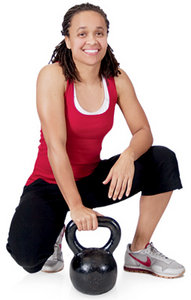Old-School Fitness
By Jeffrey Tucker, DC, DACRB
Flip through the television channels on an average day, especially first thing in the morning or late at night, and you'll see the latest, "greatest" fitness routines, techniques and tools designed to sculpt your body. Do they work any better than the "old-school" methods people have been using successfully for generations? Here's a time-tested fitness strategy that's been around for centuries and remains popular today among exercise enthusiasts looking for simple, effective ways to get in shape:
kettlebells.
There is a lot of excitement and "buzz" in gyms, fitness centers and in the rehabilitation setting these days about a piece of exercise equipment called the kettlebell. I want to introduce everyone to this exercise tool because kettlebell workouts are more fun than traditional weight machines and free-weight dumbbells, and you can engage a lot of your major muscle groups simultaneously, allowing you to improve strength, balance and endurance.
 A kettlebell or girya is a traditional Russian cast iron weight that looks like a cannonball with a handle. Picture a bowling ball with a handle on it. The kettlebell dates back four centuries; the word first appeared in a Russian dictionary in 1704. So popular were kettlebells in Tsarist Russia that any strongman or weight-lifter was referred to as a girevik or "kettlebell man."
A kettlebell or girya is a traditional Russian cast iron weight that looks like a cannonball with a handle. Picture a bowling ball with a handle on it. The kettlebell dates back four centuries; the word first appeared in a Russian dictionary in 1704. So popular were kettlebells in Tsarist Russia that any strongman or weight-lifter was referred to as a girevik or "kettlebell man."
Before you get frightened by an image of a hulking, muscled bodybuilder, bear in mind that kettlebells come in various weights - from as light as 5, 8 or 10 lbs to as heavy as 105 lbs. In short, you can use kettlebells to achieve the level of fitness you desire, just as you would with conventional free weights and other types of workout equipment. And a quick search of the Web reveals that these days, you aren't limited to the traditional iron "bowling ball" variety; you can even find kettlebells that are essentially medicine balls with handles.
You can do standard weight training exercises with kettlebells: bench presses, military presses, rows and squats. However, the unique value of kettlebells is derived from ballistic (fast exercise) work: snatches, swings, cleans and jerks. Consistent kettlebell exercises can be used to improve physical appearance, enhance cardiovascular health, decrease pain, prevent injury, reduce body fat, and increase lean muscle mass, strength, endurance, flexibility and performance.
I personally became intrigued by the claims of the advantages of the kettlebell to improve all-round fitness, enhance awareness of posture, body position, explosiveness, breath and grip, so I decided I wanted to learn how to use them. I met with a well-known kettlebell expert and took workshops from him. I also met with the person responsible for popularizing kettlebells in the U.S. He taught me some of his stretching routines. I soon found out that kettlebells are all they're cracked up to be (and more), and you don't need to purchase expensive exercise equipment or join a gym.
I especially like the cardio benefits people can get from kettlebells. It's easy to use interval training principles with kettlebells (doing an exercise fast, then slow, and repeating). I have been teaching a twice-weekly exercise class for the past four years and when I first started, we used just body-weight exercises, balance balls and bands. Every year since I started the class I've introduced a new, more challenging, tool or device.

